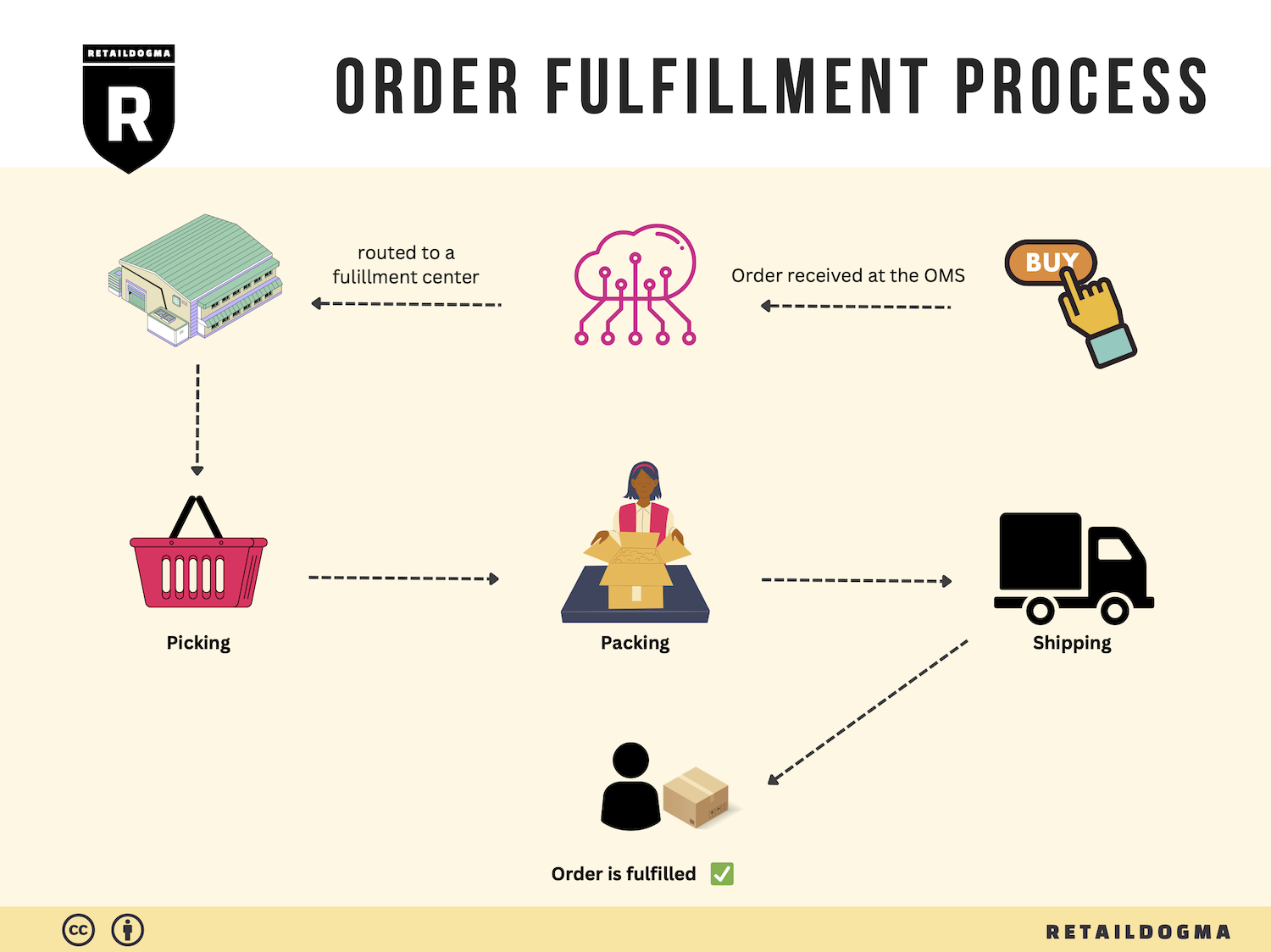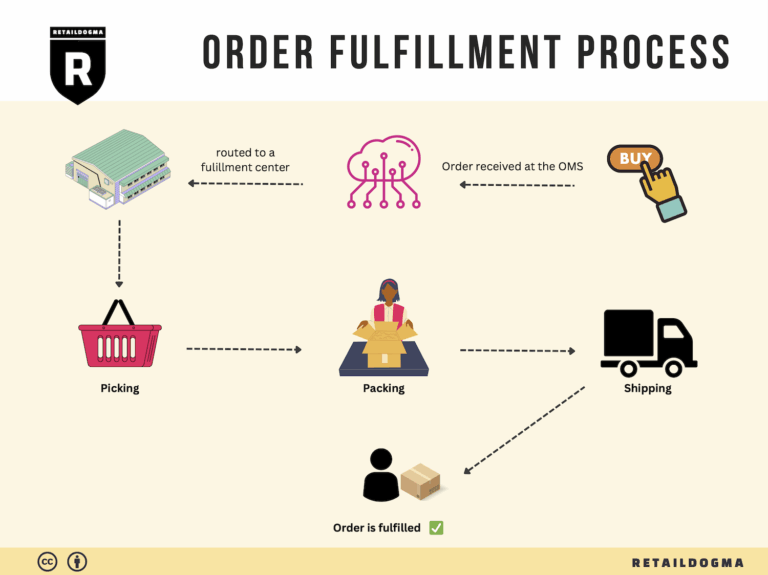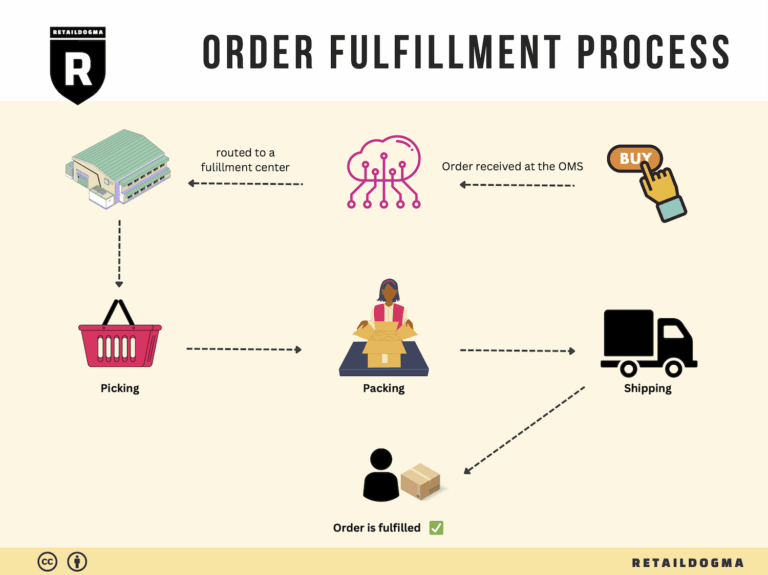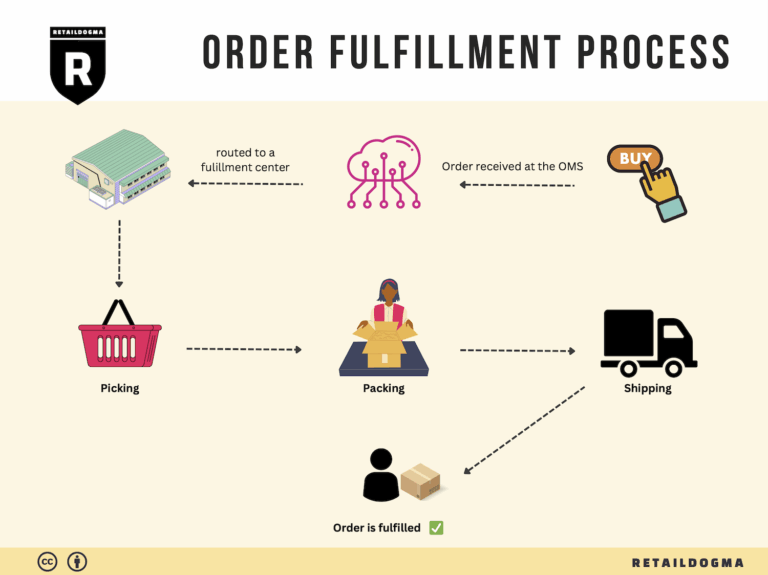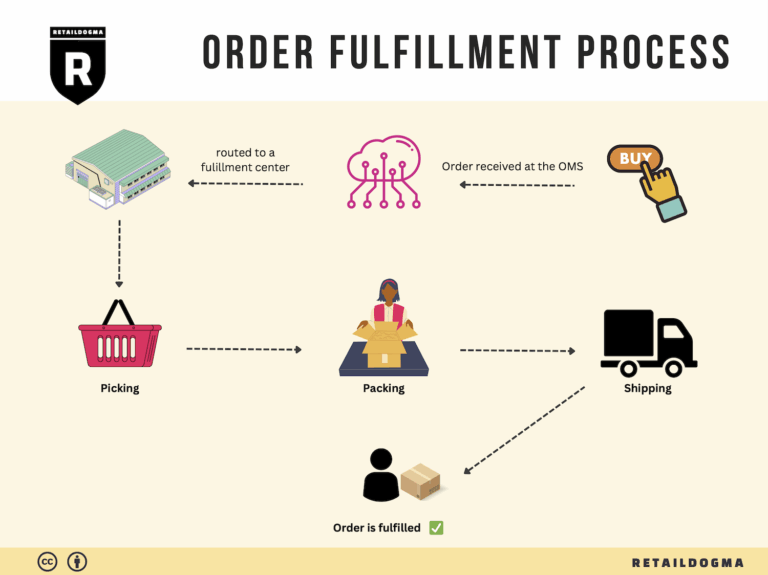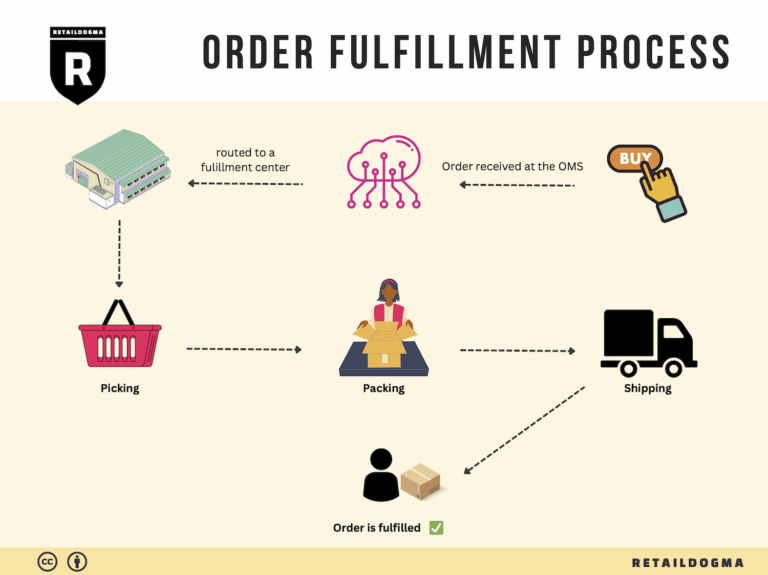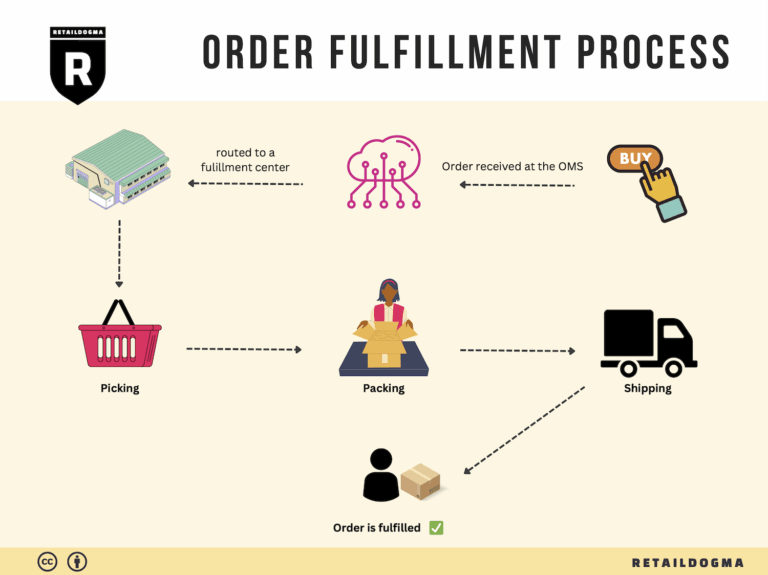Ecommerce Fulfillment Services: The Ultimate Guide (2025)
What is E-commerce Fulfillment? An Introduction for Growing Businesses
Understanding E-commerce Fulfillment: A Key to Growth
As an e-commerce business owner, you may find yourself grappling with the daunting task of packing and shipping orders. This overwhelming process can divert your attention from core business activities, stifling growth and innovation. E-commerce fulfillment, at its essence, is the systematic process of getting your products into the hands of your customers, transforming the complexities of logistics into a streamlined operation.
In this guide, we will delve into the various e-commerce fulfillment models available to growing businesses. One popular option is Third-Party Logistics (3PL), where a logistics provider manages inventory, packing, and shipping on your behalf. Alternatively, Fulfillment by Amazon (FBA) offers a hands-off solution for businesses looking to leverage Amazon’s extensive distribution network. By understanding these models, you can choose the one that best aligns with your business needs.
We will also explore the core services integral to successful fulfillment operations. These include inventory management, order processing, shipping logistics, and customer service. Each of these elements plays a crucial role in ensuring that your fulfillment process runs smoothly, enhances customer satisfaction, and ultimately drives repeat business.
Choosing the right fulfillment partner can be a game-changer for your operations. In this guide, we will provide practical tips on assessing potential partners, including evaluating their technology, scalability, and the range of services they offer. A well-aligned partnership can not only improve your efficiency but also provide the flexibility needed to adapt to market changes.
Pricing is another critical consideration in the fulfillment landscape. We will break down the various pricing structures you might encounter, from per-order fees to storage costs, helping you to make informed financial decisions that support sustainable growth.
The goal of this guide is to empower you with the knowledge necessary to navigate the complexities of e-commerce fulfillment confidently. By making informed choices about your logistics operations, you can focus on what you do best—growing your business and delighting your customers.
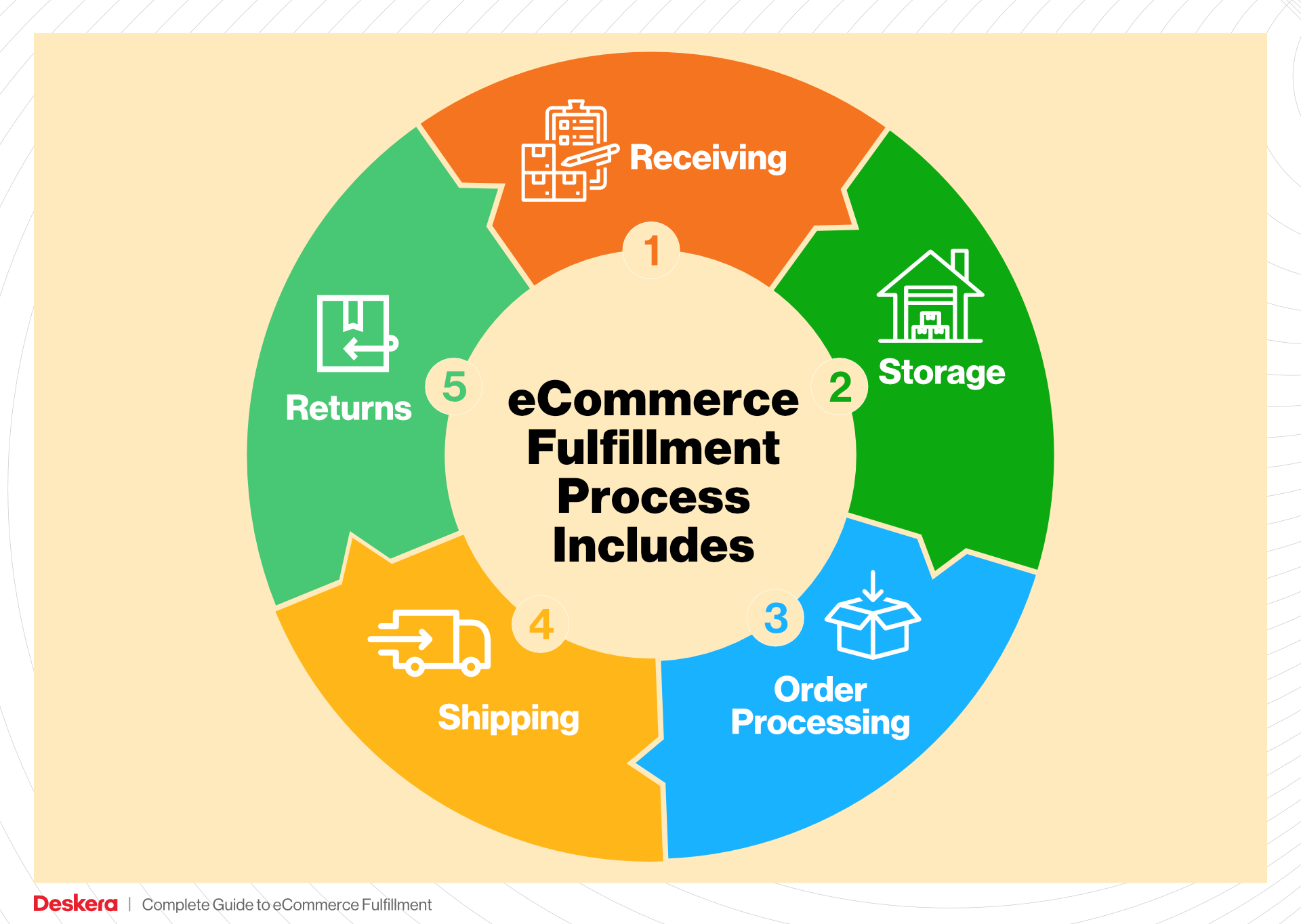
What You’ll Learn In This Guide
- What is E-commerce Fulfillment? An Introduction for Growing Businesses
- The Order Fulfillment Process: From ‘Buy’ Button to Customer’s Door
- Comparing Fulfillment Models: In-House vs. 3PL vs. Dropshipping
- A Deep Dive into Amazon FBA: Pros, Cons, and Who It’s For
- Core Services Offered by Fulfillment Centers
- How to Choose a Fulfillment Partner: A 6-Point Checklist
- Understanding Fulfillment Pricing: A Breakdown of Common Fees
- Frequently Asked Questions (FAQs) about Fulfillment
- Conclusion: Is Outsourcing Fulfillment the Right Move for Your Business?
- Important Disclaimer
The Order Fulfillment Process: From ‘Buy’ Button to Customer’s Door
1. Receiving Inventory
The first step in the order fulfillment process is receiving inventory. This involves the arrival of products from manufacturers or suppliers at the fulfillment center. Upon arrival, the goods are checked against purchase orders to ensure that the correct items and quantities have been delivered. This is crucial for maintaining inventory accuracy and preventing stock discrepancies.
During this phase, each product is assigned a unique identifier known as a Stock Keeping Unit (SKU). The SKU system allows businesses to easily track inventory levels, manage stock efficiently, and streamline the overall logistics process. Accurate receiving not only helps in minimizing errors but also sets the stage for effective order management later on.
2. Warehouse Storage
Once the inventory is received and verified, the next step is warehouse storage. This process involves organizing and storing the products in designated areas within the fulfillment center. Effective storage solutions are key to optimizing space and ensuring quick access to items when orders come in.
Proper warehouse storage techniques include categorizing products by SKU, size, or type, which aids in efficient retrieval. The use of shelving, bins, and pallet racking systems enhances organization. This step is critical because it directly impacts the speed and efficiency of order picking. A well-organized warehouse can significantly reduce the time it takes to locate and pick items, ultimately leading to quicker fulfillment times.
3. Order Picking
Order picking is the process of selecting items from their storage locations to fulfill a customer order. This step typically begins when a sales order is generated, and a pick list is created. The pick list details the items and quantities needed for each order, guiding warehouse staff to the correct locations.
Efficiency in order picking is paramount, as it can affect the entire fulfillment timeline. Various picking methods, such as single order picking, batch picking, or zone picking, can be employed based on the volume and type of orders being processed. Leveraging technology, such as barcode scanners and warehouse management systems (WMS), can further streamline this process by ensuring accuracy and reducing the likelihood of picking errors. A swift and accurate picking process contributes to overall customer satisfaction by ensuring timely and correct deliveries.
4. Order Packing
After items are picked, they move to the packing stage. This step involves carefully packing the selected items into boxes or containers for shipment. Packing is not merely about enclosing products; it also includes ensuring that items are secure and protected during transit. This is where packaging materials—such as bubble wrap, packing peanuts, and boxes—come into play.
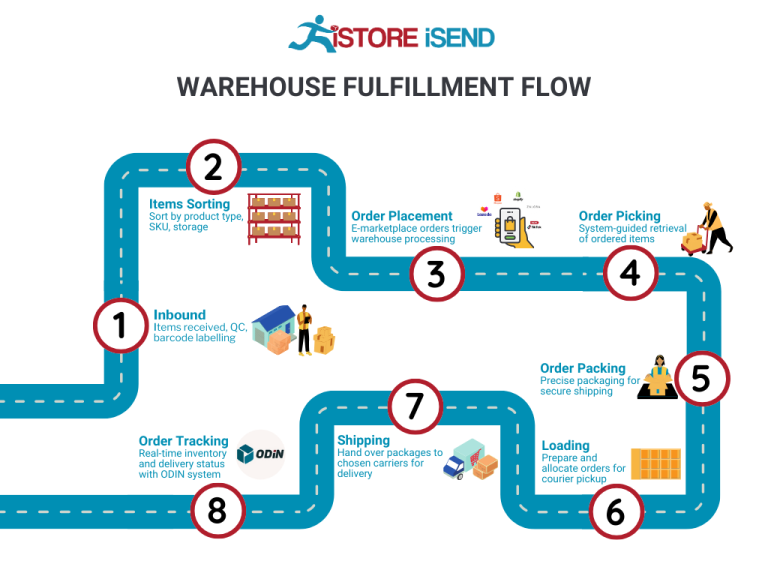
Effective packing is essential for minimizing damage during shipping and ensuring that products arrive in pristine condition. Additionally, clear labeling with shipping information and return policies helps facilitate smooth deliveries. The packing stage is vital, as it can significantly influence the customer’s perception of the brand and their overall satisfaction with the order.
5. Shipping & Delivery
The final step in the order fulfillment process is shipping and delivery. Once orders are packed, they are labeled and scheduled for shipment. This involves selecting a shipping carrier and determining the most cost-effective and timely delivery method based on the destination and urgency of the order.
In this stage, businesses often use tracking systems to provide customers with real-time updates on their order status. Effective shipping logistics are crucial, as they can impact customer satisfaction, brand reputation, and overall business efficiency. The choice of shipping methods, whether standard or expedited, plays a significant role in meeting customer expectations. Additionally, maintaining good relationships with shipping carriers can lead to better rates and improved service levels, ensuring that products reach customers’ doors promptly and reliably.
In summary, understanding and optimizing each step of the order fulfillment process—from receiving inventory to shipping and delivery—can significantly enhance operational efficiency and customer satisfaction. By focusing on key areas such as inventory accuracy, warehouse organization, picking efficiency, careful packing, and reliable shipping, e-commerce businesses can position themselves for scalable growth in a competitive marketplace.
Comparing Fulfillment Models: In-House vs. 3PL vs. Dropshipping
Comparing Fulfillment Models: Overview
In the e-commerce landscape, choosing the right fulfillment model is crucial for operational efficiency and customer satisfaction. As businesses scale, understanding the strengths and weaknesses of various fulfillment strategies can help in making informed decisions. Below is a comparison of three prevalent fulfillment models: In-House Fulfillment, Third-Party Logistics (3PL), and Dropshipping.
| Model | Who Handles Inventory | Best For (Business Stage) | Key Advantage | Key Disadvantage |
|---|---|---|---|---|
| In-House Fulfillment | The business itself | Established businesses with stable demand | Full control over inventory and operations | High overhead costs and scalability challenges |
| Third-Party Logistics (3PL) | A third-party logistics provider | Startups and growing businesses | Flexibility and scalability with reduced risk | Less control over inventory and fulfillment speed |
| Dropshipping | Supplier or manufacturer | New and small businesses | Low upfront investment and minimal risk | Lower profit margins and less control over product quality |
In-House Fulfillment
In-house fulfillment involves managing all aspects of inventory and shipping operations internally. This model is best suited for established businesses with stable demand, as it allows for complete control over inventory management, order processing, and customer service. Businesses that choose this model typically invest in warehousing space, staffing, and logistics technology to streamline operations.
Key Advantages: The primary advantage of in-house fulfillment is the ability to maintain full control over every aspect of the fulfillment process. This includes monitoring inventory levels, ensuring product quality, and providing personalized customer service. Businesses can implement tailored processes that reflect their unique brand identity and customer expectations. Additionally, having direct oversight can lead to faster response times when addressing customer inquiries or issues.
Key Disadvantages: However, this model comes with significant challenges. High overhead costs associated with warehousing, staffing, and technology can strain finances, especially for smaller businesses. Additionally, scaling operations can become cumbersome as demand fluctuates, requiring businesses to invest further in infrastructure and resources. This model can also lead to inefficiencies if not managed properly, potentially harming customer satisfaction.
Third-Party Logistics (3PL)
Third-party logistics (3PL) involves partnering with an external logistics provider to handle inventory storage, order fulfillment, and shipping. This model is particularly advantageous for startups and growing businesses that seek flexibility without the burden of managing logistics in-house. 3PL providers can scale operations quickly in response to market demands, offering a suite of services that include warehousing, inventory management, and freight shipping.
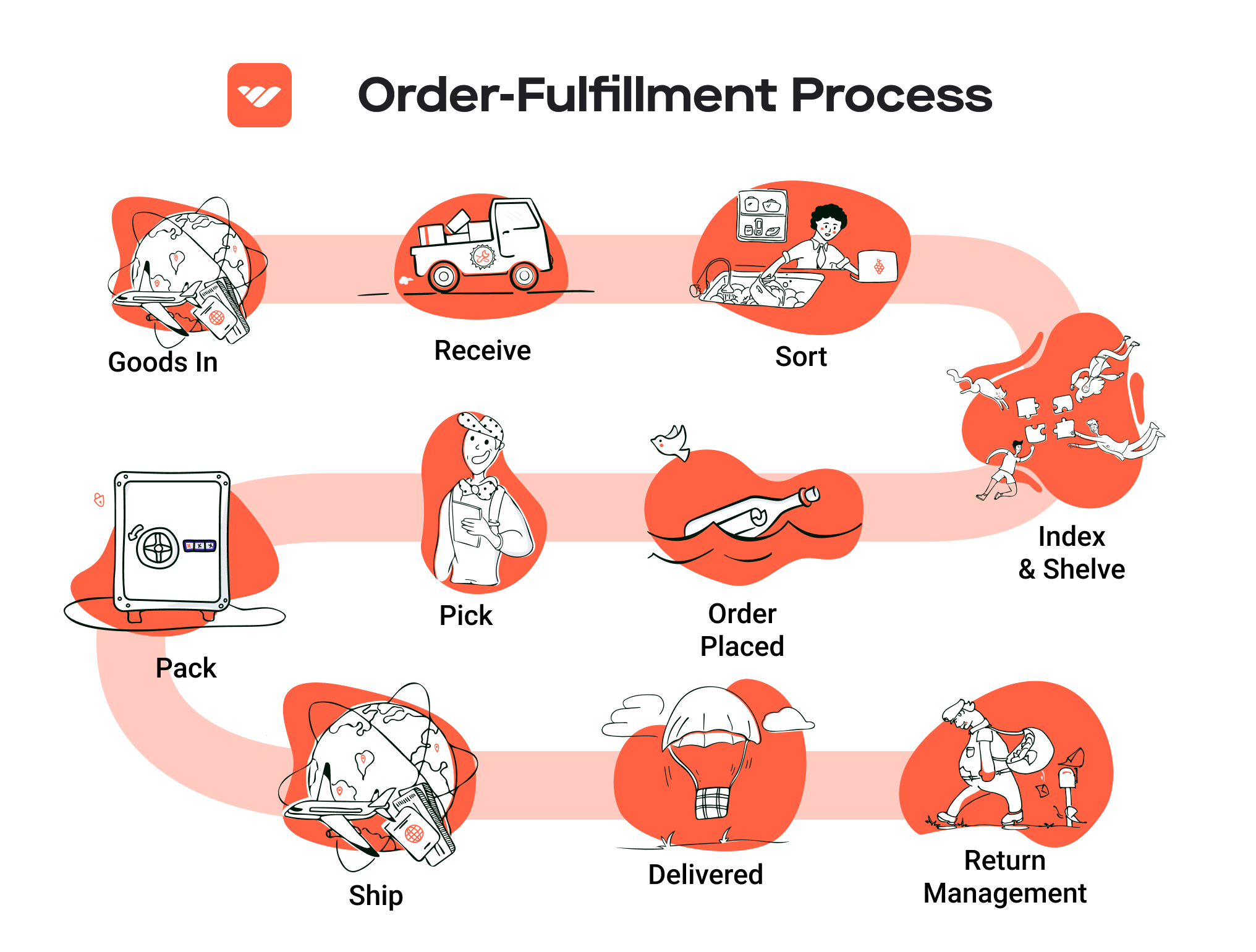
Key Advantages: The main advantage of utilizing a 3PL is the ability to scale operations without the heavy upfront investment required for in-house fulfillment. 3PLs offer expertise in logistics, which can lead to improved efficiency and cost savings. By leveraging their established networks and technology, businesses can optimize shipping routes, reduce freight costs, and improve delivery times. This flexibility allows businesses to focus on core competencies like marketing and product development rather than logistics.
Key Disadvantages: On the downside, outsourcing fulfillment can lead to a loss of control over inventory and fulfillment processes. Businesses may face challenges in maintaining quality standards and ensuring timely deliveries, particularly if the 3PL partner does not align with their operational expectations. Additionally, while the initial costs may be lower, businesses must consider ongoing fees and contracts, which can add up over time and impact profit margins.
Dropshipping
Dropshipping is a fulfillment model where the retailer does not hold inventory but instead relies on suppliers or manufacturers to fulfill orders directly to customers. This model is ideal for new and small businesses looking to enter the market with minimal investment. In dropshipping, when a retailer sells a product, they purchase it from a third party who then ships it directly to the customer.
Key Advantages: The primary benefit of dropshipping is the low upfront investment required to start a business. Entrepreneurs can set up an online store without the need for inventory, warehousing, or fulfillment logistics. This model significantly reduces financial risk, as businesses only pay for products after they have made a sale. Additionally, dropshipping allows for a diverse product offering without the complications of inventory management.
Key Disadvantages: However, dropshipping comes with its own set of challenges. Profit margins are typically lower compared to other fulfillment models, as retailers must pay wholesale prices to suppliers. Additionally, retailers have less control over product quality, shipping times, and customer service, which can lead to customer dissatisfaction. Dependence on suppliers can also pose risks, particularly if they fail to fulfill orders accurately or on time, potentially damaging the retailer’s reputation.
Conclusion
In summary, each fulfillment model presents unique advantages and challenges that businesses must consider when scaling their operations. In-house fulfillment offers control and personalization but comes with high overhead costs. Third-party logistics provide flexibility and scalability, while dropshipping minimizes risk and investment but can compromise quality and margins. Understanding these dynamics will enable e-commerce business owners to select the model that best aligns with their operational goals and market demands.
A Deep Dive into Amazon FBA: Pros, Cons, and Who It’s For
Understanding Fulfillment by Amazon (FBA)
Fulfillment by Amazon (FBA) is a service offered by Amazon that allows e-commerce sellers to store their products in Amazon’s fulfillment centers. When a customer places an order, Amazon handles the storage, packaging, and shipping of the product directly to the customer. This service is particularly appealing for businesses looking to scale their sales and logistics without the complexities of managing warehousing and shipping themselves.
How FBA Works
-
Product Listing: Sellers create product listings on Amazon and specify that they want to use FBA.
-
Inventory Shipment: Sellers send their inventory to Amazon’s fulfillment centers. Amazon provides guidelines on how to prepare and package products to ensure they meet their requirements.
-
Storage: Once received, Amazon stores the products in their warehouses. Sellers can monitor their inventory levels through the Amazon Seller Central dashboard.
-
Order Processing: When a customer orders a product, Amazon picks, packs, and ships the item on behalf of the seller. This process is handled quickly, often resulting in same-day or next-day delivery.
-
Customer Service: Amazon also manages customer service and returns for FBA orders, providing a seamless experience for both sellers and customers.
-
Fees: Sellers are charged fees for using FBA, which typically include storage fees for inventory and fulfillment fees per order.
Pros of Fulfillment by Amazon
1. Prime Eligibility
One of the most significant advantages of FBA is that products become eligible for Amazon Prime. This feature attracts a vast customer base that is willing to pay for expedited shipping, resulting in increased sales for sellers.
2. Customer Trust
Amazon is a well-established brand known for its customer service. By using FBA, sellers can leverage Amazon’s reputation, which builds trust with customers. Buyers often feel more secure purchasing from FBA sellers due to the hassle-free return policies and reliable shipping.
3. Multi-Channel Fulfillment
FBA isn’t limited to Amazon sales. Sellers can use FBA to fulfill orders from their own e-commerce websites or other marketplaces. This multi-channel fulfillment capability allows businesses to streamline their logistics under one roof, reducing complexity.
4. Scalability
FBA allows businesses to scale quickly without the need for additional warehousing or logistics staff. As demand grows, sellers can increase their inventory levels in Amazon’s fulfillment centers without worrying about fulfillment logistics.
5. Enhanced Visibility
Sellers using FBA benefit from Amazon’s advanced logistics and analytics tools. They can track inventory levels, monitor sales performance, and optimize their listings based on real-time data.
Cons of Fulfillment by Amazon
1. High Fees
While FBA offers significant advantages, it comes with a cost. Sellers must pay for storage, fulfillment, and additional service fees, which can add up quickly. For low-margin products, these costs can erode profits significantly.
2. Strict Inventory Rules
Amazon has stringent inventory management policies. Sellers must comply with guidelines regarding product preparation, labeling, and storage limits. Non-compliance can lead to additional fees or even inventory removal.
3. Commingling Risks
FBA operates on a commingling model, meaning that inventory from different sellers may be mixed in the same warehouse. This can pose risks for sellers, as they may receive returns or shipments that do not belong to them, potentially damaging their brand reputation.
4. Loss of Control
Using FBA means relinquishing some control over the fulfillment process. Sellers are dependent on Amazon’s systems, which can lead to issues if there are inventory discrepancies or fulfillment errors.
5. Complicated Returns Process
While Amazon manages returns for FBA orders, the process can sometimes be complicated for sellers. Returns may not be processed as expected, and sellers have limited recourse for addressing issues with returned items.
Who is FBA Best For?
Fulfillment by Amazon is ideal for a range of sellers, particularly those who are:
-
Small to Medium-Sized Businesses: Sellers looking to grow their operations without investing heavily in logistics infrastructure can benefit from FBA’s scalability.
-
E-commerce Entrepreneurs: Individuals launching new products can leverage FBA to access Amazon’s vast customer base and benefit from Prime eligibility.
-
Brands with High Sales Volume: Companies that sell products with higher margins can absorb the fees associated with FBA while still maintaining profitability.
-
Sellers with Diverse Product Lines: Businesses offering various products can simplify their fulfillment processes by utilizing FBA for multi-channel sales.
-
Those Seeking Customer Trust: Sellers who want to establish credibility and trust quickly can benefit from Amazon’s reputation and customer service capabilities.
In conclusion, FBA can significantly enhance the logistics and fulfillment capabilities of e-commerce businesses. However, it is crucial to weigh the pros and cons carefully to determine if it aligns with your business model and growth strategy. By understanding how FBA works and who it best serves, you can make an informed decision about whether to integrate this service into your operations.
Core Services Offered by Fulfillment Centers
Inventory Management & Warehousing
Inventory management and warehousing are foundational services provided by fulfillment centers, crucial for the efficient operation of e-commerce businesses. This service encompasses the systematic tracking of inventory levels, orders, sales, and deliveries, ensuring that businesses have the right products in stock at the right time.
What It Is:
Fulfillment centers utilize advanced software systems to monitor inventory in real-time, allowing businesses to maintain accurate stock levels and avoid overstocking or stockouts. They store products in strategically located warehouses, which can vary in size and capacity depending on the client’s needs.
Benefits to E-commerce Businesses:
1. Cost Efficiency: By outsourcing warehousing, businesses can save on overhead costs associated with maintaining their own storage facilities. Fulfillment centers often provide economies of scale, reducing per-unit costs.
2. Scalability: As demand fluctuates, fulfillment centers can adjust storage space accordingly, enabling businesses to scale operations without the burden of long-term leases or excess inventory.
3. Streamlined Operations: With automated inventory tracking, businesses can respond quickly to market changes, optimizing their supply chain and improving order fulfillment speed.
Pick and Pack Services
Pick and pack services are integral to the fulfillment process, where individual items are selected from inventory (picked) and packaged for shipment (packed) according to customer orders.
What It Is:
In this service, fulfillment center staff or automated systems retrieve the correct items from the warehouse based on incoming orders. After picking, the items are packed into boxes or containers, often with attention to branding and customer experience, and then prepared for shipping.
Benefits to E-commerce Businesses:
1. Accuracy and Efficiency: Fulfillment centers employ trained personnel and sophisticated technology to minimize errors in order fulfillment. This accuracy reduces returns and enhances customer satisfaction.
2. Faster Turnaround Times: With dedicated pick and pack teams, orders can be processed quickly, ensuring that customers receive their products promptly. This speed is crucial for maintaining competitive advantage in the e-commerce space.
3. Customization Options: Many fulfillment centers offer customizable packing options, such as including branded materials or promotional items, which can enhance the customer experience and encourage repeat business.
Kitting and Assembly
Kitting and assembly services involve bundling multiple products into a single package or assembling components into a finished product before shipping.
What It Is:
Kitting refers to the process of grouping related items together into a single kit or package, while assembly involves putting together various parts to create a complete product. This service is especially useful for businesses that offer subscription boxes, promotional bundles, or customized products.
Benefits to E-commerce Businesses:
1. Enhanced Customer Experience: By offering kitted products, businesses can provide customers with a convenient solution that meets their specific needs, potentially increasing sales and customer loyalty.
2. Operational Efficiency: Outsourcing kitting and assembly allows businesses to focus on core competencies while ensuring that complex product configurations are handled by experts. This can lead to faster production cycles and reduced lead times.
3. Inventory Optimization: By consolidating inventory through kitting, businesses can reduce the number of individual SKUs they manage, simplifying inventory control and improving efficiency.
Returns Management (Reverse Logistics)
Returns management, often referred to as reverse logistics, is a critical service offered by fulfillment centers, focusing on the handling of returned products.
What It Is:
This service involves processing returns from customers, assessing the condition of returned items, restocking them if possible, and managing any necessary repairs or refurbishments. Effective returns management is essential for maintaining customer satisfaction and loyalty.
Benefits to E-commerce Businesses:
1. Streamlined Returns Process: A dedicated fulfillment center can handle returns efficiently, ensuring that customers receive prompt responses and resolutions, which can enhance their overall shopping experience.
2. Cost Recovery: By assessing and refurbishing returned products, businesses can recover value from items that might otherwise be considered a loss, thus improving profit margins.
3. Data Insights: Fulfillment centers often provide analytics on returns, helping businesses understand the reasons behind product returns. This data can be invaluable for improving product quality, customer service, and inventory management.
In summary, leveraging the core services of fulfillment centers—inventory management and warehousing, pick and pack services, kitting and assembly, and returns management—can significantly enhance the operational efficiency and scalability of e-commerce businesses. By partnering with a fulfillment center, businesses can focus on growth and customer satisfaction while leaving the complexities of logistics and supply chain management to experts.
How to Choose a Fulfillment Partner: A 6-Point Checklist
Location & Warehouse Network
Importance: The geographic location of your fulfillment partner’s warehouses can significantly impact shipping times and costs. Ideally, their facilities should be strategically located to minimize transit times to your customers, especially if you serve a national or international market.
Questions to Ask:
– Where are your warehouses located, and how many do you operate?
– Can you provide insights on average shipping times to various regions?
– How do you handle last-mile delivery to ensure timely fulfillment?
Technology & Integrations
Importance: A fulfillment partner’s technology stack is crucial for seamless operations. Robust systems can improve inventory management, order tracking, and data analytics, allowing for better decision-making and efficiency.
Questions to Ask:
– What warehouse management system (WMS) do you use, and how does it integrate with my existing platforms (e.g., e-commerce, ERP)?
– Can you provide real-time inventory updates and order tracking?
– How do you handle data security and privacy?
Specializations (e.g., Cold Storage, Oversized Items)
Importance: Depending on your product types, you may require specialized handling. For example, if you deal with perishable goods or oversized items, it’s essential to partner with a provider that can accommodate these needs.
Questions to Ask:
– Do you have the capability for specialized storage (e.g., cold storage, hazardous materials)?
– What experience do you have in handling products similar to mine?
– How do you ensure compliance with industry standards and regulations for specialized items?
Scalability & Capacity
Importance: As your business grows, your fulfillment needs will evolve. Choosing a partner that can scale with you is vital for avoiding disruptions and ensuring consistent service levels.
Questions to Ask:
– What is your current capacity, and how do you manage fluctuations in order volume?
– Can you support peak seasons, such as holidays or sales events?
– How do you plan for expansion in terms of facilities and technology?
Pricing and Contracts
Importance: Understanding the pricing structure and contract terms is essential to avoid unexpected costs and ensure the partnership aligns with your budget and financial goals.
Questions to Ask:
– What are your pricing models (e.g., per order, per item, monthly fees)?
– Are there any hidden fees (e.g., storage, handling, returns)?
– What is the length of the contract, and what are the terms for termination or renewal?
Customer Support & Reviews
Importance: Reliable customer support can be a lifesaver during critical times. Additionally, reviews and testimonials can provide insights into the partner’s reputation and service quality.
Questions to Ask:
– What customer support options do you offer (e.g., phone, email, chat)?
– Can you provide references or case studies from similar businesses?
– How do you handle issues such as order inaccuracies or shipping delays?
Conclusion
Choosing the right fulfillment partner is a critical decision that can significantly affect your business’s efficiency, customer satisfaction, and overall growth. By using this checklist, you can systematically evaluate potential partners and ensure they align with your operational needs and strategic goals. Each of these points will help you not only to find a provider that meets your current requirements but also one that can adapt and grow with your business.
Understanding Fulfillment Pricing: A Breakdown of Common Fees
Initial Setup Fees
When partnering with a third-party logistics provider (3PL) for B2B fulfillment, you can expect to incur initial setup fees. These costs are typically associated with the onboarding process, which may involve integrating your systems with the 3PL’s technology, setting up your inventory in their warehouse management system (WMS), and customizing any necessary processes to meet your specific business needs.
The calculation of initial setup fees can vary widely based on the complexity of your operations. Factors that may influence the fee include the volume of products being managed, the level of customization required, and any additional services you may need, such as branding or packaging modifications. It’s advisable to discuss these needs upfront to understand what the initial costs will encompass.
Receiving Fees
Receiving fees are charged when your products arrive at the fulfillment center. This fee covers the labor involved in unloading, inspecting, and entering the inventory into the 3PL’s system.
Typically, receiving fees are calculated based on the volume of goods received, either by weight or by the number of pallets. For instance, a 3PL may charge a flat fee per pallet received or a per-hour rate based on the time taken to process incoming shipments. Be sure to inquire about any additional costs that could arise from special handling requirements, such as fragile items or bulk orders, as these can add to your overall receiving costs.
Storage Fees (per pallet/bin)
Once your inventory is stored in the fulfillment center, storage fees will apply. These fees are charged for the space your products occupy in the warehouse and can be structured either per pallet or per bin, depending on how your goods are stored.
Storage fees are typically calculated on a monthly basis. For example, you might pay a set amount for each pallet stored, which can vary depending on the location and size of the fulfillment center. Additionally, some 3PLs may implement tiered pricing based on the volume of storage space you utilize, potentially offering lower rates for higher volumes. It’s essential to understand how your storage needs will evolve as your business scales and to negotiate terms that accommodate growth.
Pick & Pack Fees (per item/order)
Pick and pack fees are one of the most significant costs associated with fulfillment services. These fees cover the labor involved in picking items from inventory, packing them for shipment, and preparing them for delivery to your customers.
This fee is usually calculated on a per-item or per-order basis. For instance, you might pay a flat fee for each item picked and packed or a single fee for each order processed, regardless of the number of items. Some 3PLs may also charge additional fees for special packing requirements, such as custom packaging or additional inserts. Understanding the structure of these fees is crucial for budgeting and forecasting, especially as order volume fluctuates.
Shipping Fees
Shipping fees represent a significant portion of your fulfillment costs and can vary based on several factors, including the shipping method, destination, package dimensions, and weight.
3PLs typically calculate shipping fees using carrier rates, which can include both domestic and international shipping options. Additionally, some providers may offer discounted rates through their partnerships with carriers, which can be a cost-saving opportunity for your business. It’s also important to consider any potential surcharges for expedited shipping or remote area delivery.
Given that shipping is a variable cost, it’s wise to engage in discussions about shipping strategies and options that can help mitigate expenses, such as utilizing freight consolidation or just-in-time fulfillment strategies.
Tips for Getting an Accurate Quote
To ensure you receive an accurate quote from a fulfillment provider, consider the following tips:
-
Provide Detailed Information: Clearly outline your product types, dimensions, and weights. Include any special handling requirements that may affect pricing.
-
Discuss Volume Projections: Share your expected order volume and growth projections. This can help the 3PL tailor their services and potentially offer volume discounts.
-
Request Itemized Quotes: Ask for a breakdown of all potential fees, including setup, receiving, storage, pick & pack, and shipping. This transparency will help you make informed comparisons between providers.
-
Negotiate Terms: Don’t hesitate to negotiate terms and pricing, especially if you have multiple providers you are considering. Many 3PLs are willing to adjust their fees to secure your business.
-
Consider Additional Services: If you anticipate needing value-added services like kitting or custom packaging, ensure these are included in your discussions to avoid unexpected costs.
By following these guidelines, you can better navigate the complexities of fulfillment pricing and select a partner that aligns with your business goals.
Frequently Asked Questions (FAQs) about Fulfillment
1. What is B2B fulfillment?
B2B fulfillment refers to the process where a third-party logistics provider (3PL) manages the shipping of products from one business to another. This includes receiving, storing, packaging, and shipping bulk orders to retailers or other businesses, streamlining the supply chain and enhancing logistics efficiency.
2. What is a 3PL?
A 3PL, or third-party logistics provider, is a company that offers outsourced logistics services, including transportation, warehousing, and fulfillment. By partnering with a 3PL, businesses can leverage specialized expertise, advanced technology, and established networks to optimize their supply chain operations and improve delivery times.
3. How much do fulfillment services cost?
The cost of fulfillment services can vary widely based on factors such as order volume, storage space required, and specific services needed (like kitting or assembly). Generally, fees may include storage costs, pick and pack fees, shipping charges, and additional service fees. Businesses should request quotes from multiple providers to compare pricing structures.
4. What’s the difference between a warehouse and a fulfillment center?
A warehouse primarily serves as a storage facility for inventory, focusing on holding goods until they are needed. In contrast, a fulfillment center is designed for processing orders efficiently, including picking, packing, and shipping products directly to customers or businesses. Fulfillment centers often incorporate advanced technology to streamline order processing.
5. What services do B2B fulfillment providers typically offer?
B2B fulfillment providers offer a range of services, including inventory management, order processing, shipping coordination, returns management, and value-added services such as kitting and assembly. They can also assist with freight consolidation and just-in-time (JIT) delivery to enhance supply chain efficiency.
6. How can B2B fulfillment improve my supply chain resilience?
Partnering with a B2B fulfillment provider can enhance supply chain resilience by aligning inventory with demand, reducing stockouts, and optimizing shipping processes. A reliable 3PL can help businesses navigate disruptions, maintain consistent delivery schedules, and adapt to changing market conditions.
7. What is freight consolidation, and how does it benefit my business?
Freight consolidation is a logistics strategy that combines multiple smaller shipments into a single larger shipment. This approach reduces transportation costs, improves efficiency, and maximizes container utilization. By consolidating shipments, businesses can take advantage of lower freight rates and enhance their overall logistics performance.
8. How does just-in-time (JIT) fulfillment work?
Just-in-time (JIT) fulfillment is a strategy that aims to deliver products precisely when they are needed, minimizing inventory costs. A 3PL specializing in JIT fulfillment helps businesses manage their supply chains effectively by ensuring that goods are available for production or sale without excessive stockpiling, thus improving cash flow.
9. What are the compliance requirements for B2B fulfillment?
Compliance requirements vary depending on the industry and the products being handled. For example, businesses in the food and beverage or healthcare sectors may need to adhere to strict recordkeeping and quality control standards. A competent B2B fulfillment provider can help maintain compliance by implementing necessary processes and documentation.
10. How can I choose the right B2B fulfillment partner for my business?
When selecting a B2B fulfillment partner, consider factors such as their industry experience, service offerings, technology capabilities, and geographic reach. Evaluate their ability to scale with your business, provide customized solutions, and maintain high service levels. It’s also beneficial to read customer reviews and request case studies to assess their performance and reliability.
Conclusion: Is Outsourcing Fulfillment the Right Move for Your Business?
Evaluating the Benefits of Outsourcing Fulfillment
Outsourcing fulfillment can be a transformative strategy for e-commerce businesses looking to scale efficiently. By partnering with a third-party logistics provider (3PL), you gain access to specialized expertise that can streamline your operations and enhance your service delivery. This collaboration not only saves you valuable time, allowing you to focus on core business activities such as marketing and customer engagement, but it also provides the scalability needed to adapt to fluctuating demand.
One of the most significant advantages of utilizing a fulfillment service is the ability to scale operations rapidly. As your business grows, your 3PL partner can seamlessly accommodate increased order volumes, diverse product lines, and geographic expansion without the need for substantial investment in infrastructure. This flexibility allows you to respond to market trends and customer preferences swiftly, ensuring you remain competitive.
Furthermore, working with a seasoned fulfillment partner provides you with insights and operational efficiencies that may be challenging to achieve in-house. From inventory management to shipping logistics, a 3PL can optimize your supply chain processes, minimizing stockouts and excess inventory while ensuring compliance with industry regulations.
However, the success of this strategy hinges on choosing the right fulfillment partner. It’s crucial to evaluate potential partners based on their experience, technological capabilities, and alignment with your business goals. A well-suited 3PL can be a strategic ally in driving growth and resilience in your supply chain.
As you contemplate the next steps for your business, consider conducting a thorough audit of your current shipping processes. Assess whether outsourcing fulfillment could enhance your operational efficiency and support your growth objectives. Taking this proactive approach will position your business to capitalize on the advantages of a robust fulfillment strategy.
Important Disclaimer
⚠️ Important Disclaimer
The information in this guide is for educational purposes. Fulfillment services, pricing, and platform features change frequently. Always conduct your own due diligence and consult with providers directly before making business decisions.
